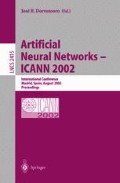Abstract
A connectionist architecture enables a society of agents to efficiently construct 2D structures. The agents use internal spatial maps to compute a sequence of construction actions that reduces total distance traveled. All computations are done over grids of neurons interacting locally. Simulation results are presented.
This work supported in part by an Intel University Research Program grant to the second author.
Access this chapter
Tax calculation will be finalised at checkout
Purchases are for personal use only
Preview
Unable to display preview. Download preview PDF.
References
D. Avis. A survey of heuristics for the weighted matthing problem. Networks, 13:475–493, 1983.
G. Chao, A. Panangadan, and M. G. Dyer. Learning to integrate reactive and planning behaviors for construction. In Proceedings of the 6th International Conference On the Simulation Of Adaptive Behavior, 2000.
G. Dorigo, M. Di Caro. Antnet: Distributed stigmergetic control for communications networks. Journal of Artificial Intelligence Research, 9:317–265, 1998.
A. H. Gee, S. V. B. Aiyer, and R. Prager. An analytical framework for optimizing neural networks. Neural Networks, 6:79–97, 1993.
J. Hopfield and D. Tank. Neural computation of decisions in optimization problems. Biological Cybernetics, 52:141–152, 1985.
C. Intanagonwiwat, R. Govindan, and D. Estrin. Directed diffusion: A scalable and robust communication paradigm for sensor networks. In Proc of the 6th Annual Intl. Conf. on Mobile Computing and Networks (MobiCOM 2000), 2000.
S. Y. Kung. Digital Neural Network, chapter 9. PTR Prentice Hall, 1993.
J. M. Kurtzberg. On approximation methods for the assignment problems. J. As-soc. Comput. Mach., 9:419–439, 1962.
M. A. Lewis and G. A. Bekey. The behavioral self-organization of nanorobots using local rules. In Proc. of the 1992IEEE/RSJ Intl. Conf. on Intelligent Robots and Systems, 1992.
A. Panangadan and M. G. Dyer. Construction by autonomous agents in a simulated environment. In Proc. of the Intl. Conf. on Artificial Neural Networks, 2001.
D. Payton, M. Daily, R. Estkowski, M. Howard, and C. Lee. Pheromone robotics. Autonomous Robots, 11(3), 2001.
G. V. Wilson and G. S. Pawley. On the stability of the travelling salesman problem algorithm of Hopfield and Tank. Biological Cybernetics, 58:63–70, 1988.
Author information
Authors and Affiliations
Editor information
Editors and Affiliations
Rights and permissions
Copyright information
© 2002 Springer-Verlag Berlin Heidelberg
About this paper
Cite this paper
Panangadan, A., Dyer, M.G. (2002). Goal Sequencing for Construction Agents in a Simulated Environment. In: Dorronsoro, J.R. (eds) Artificial Neural Networks — ICANN 2002. ICANN 2002. Lecture Notes in Computer Science, vol 2415. Springer, Berlin, Heidelberg. https://doi.org/10.1007/3-540-46084-5_157
Download citation
DOI: https://doi.org/10.1007/3-540-46084-5_157
Published:
Publisher Name: Springer, Berlin, Heidelberg
Print ISBN: 978-3-540-44074-1
Online ISBN: 978-3-540-46084-8
eBook Packages: Springer Book Archive

